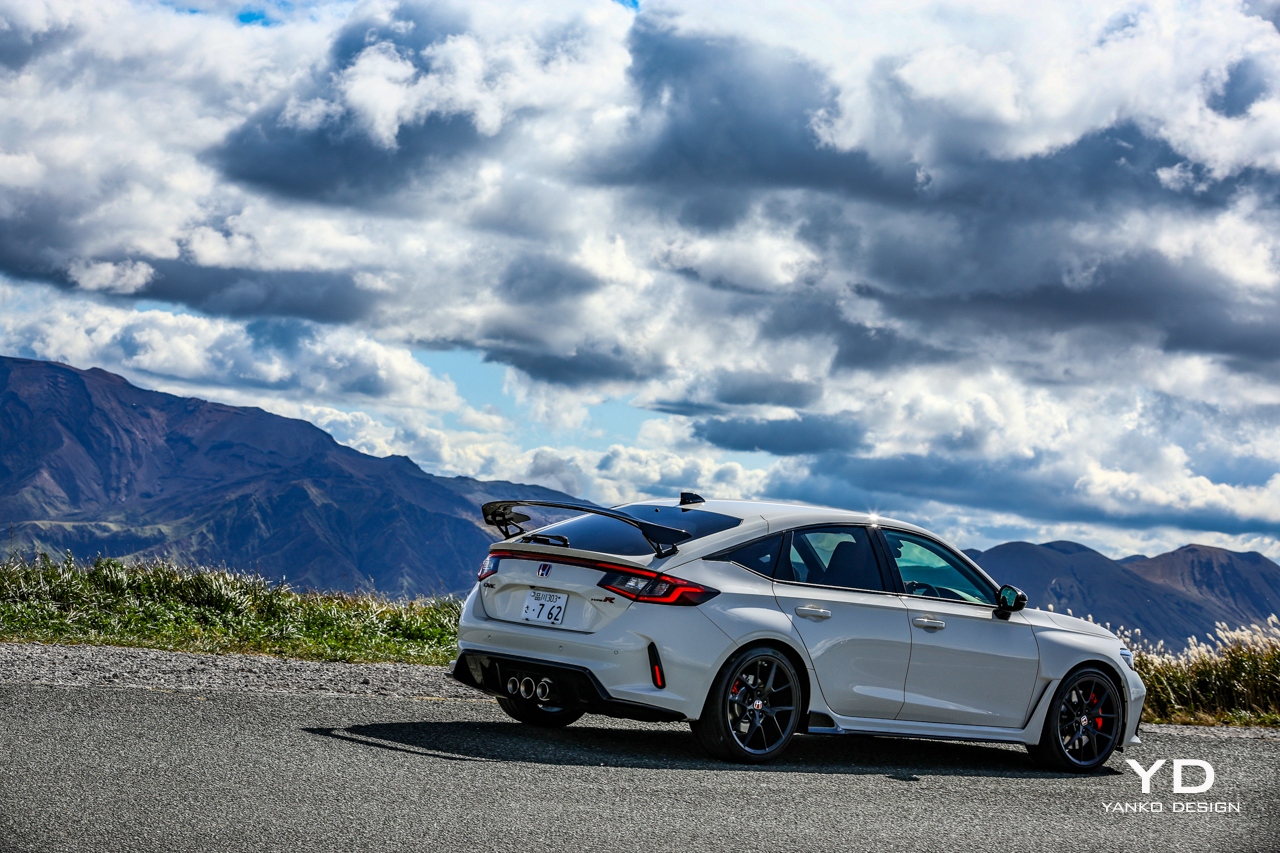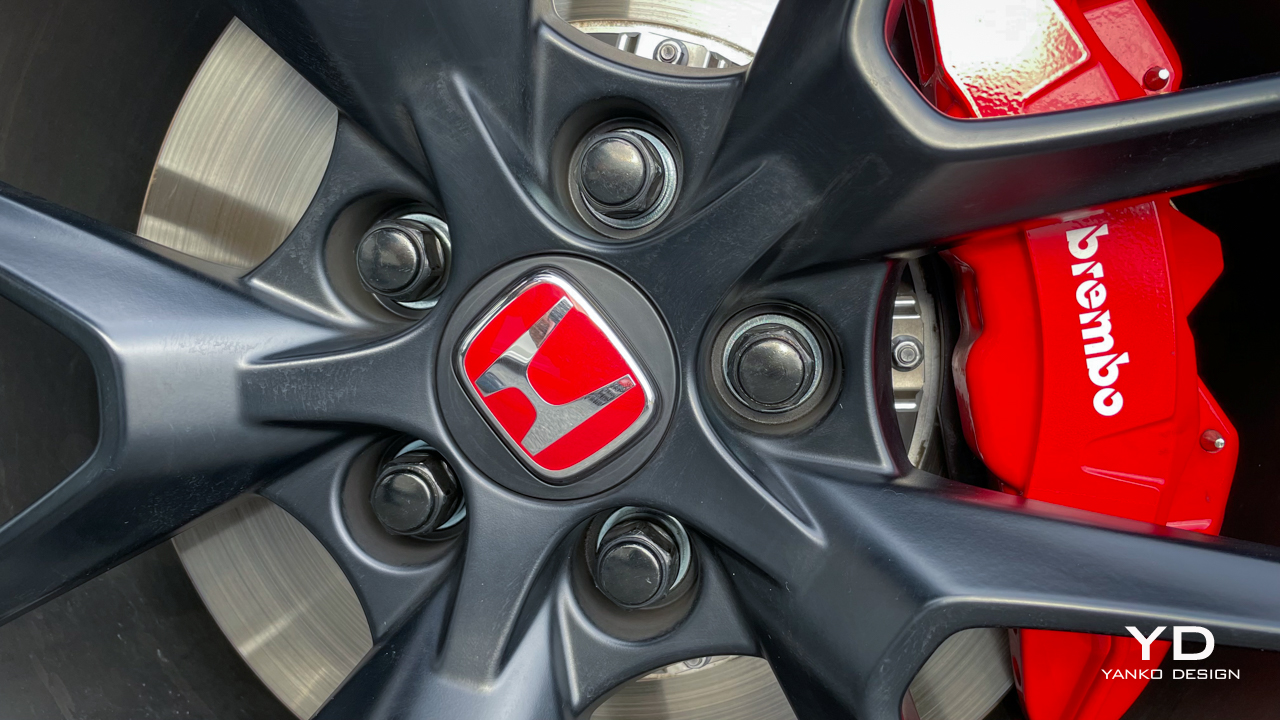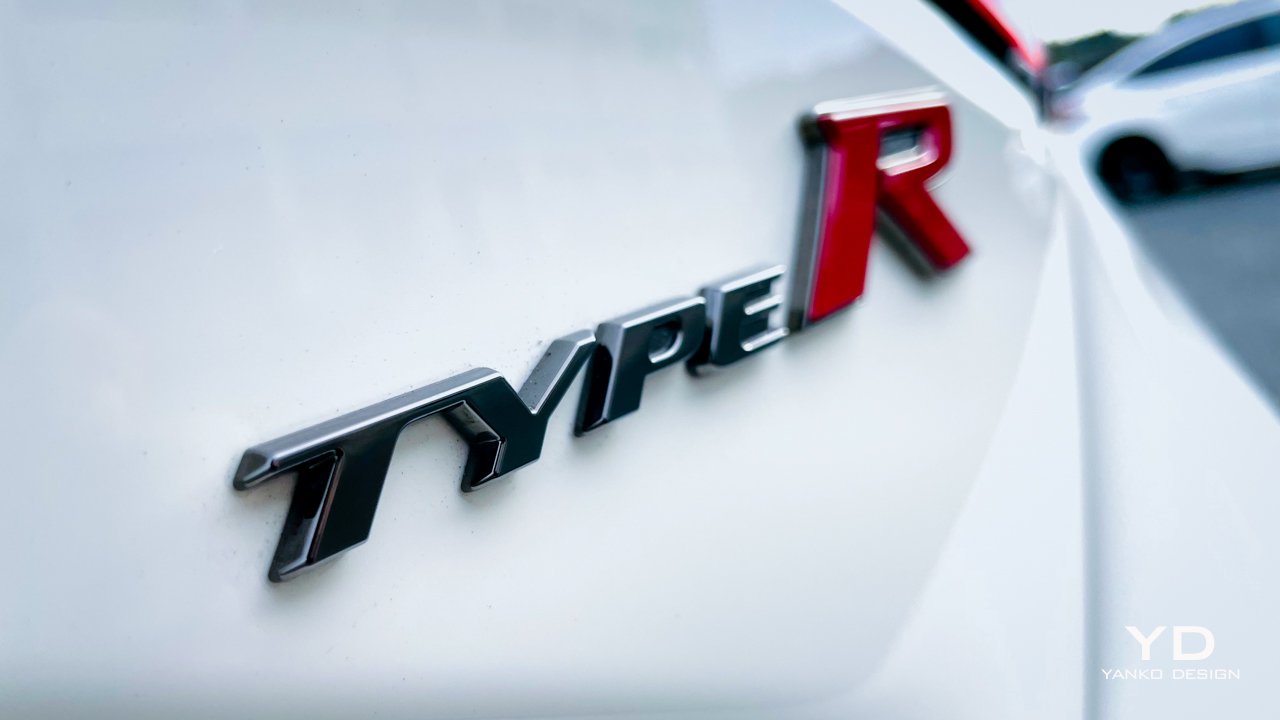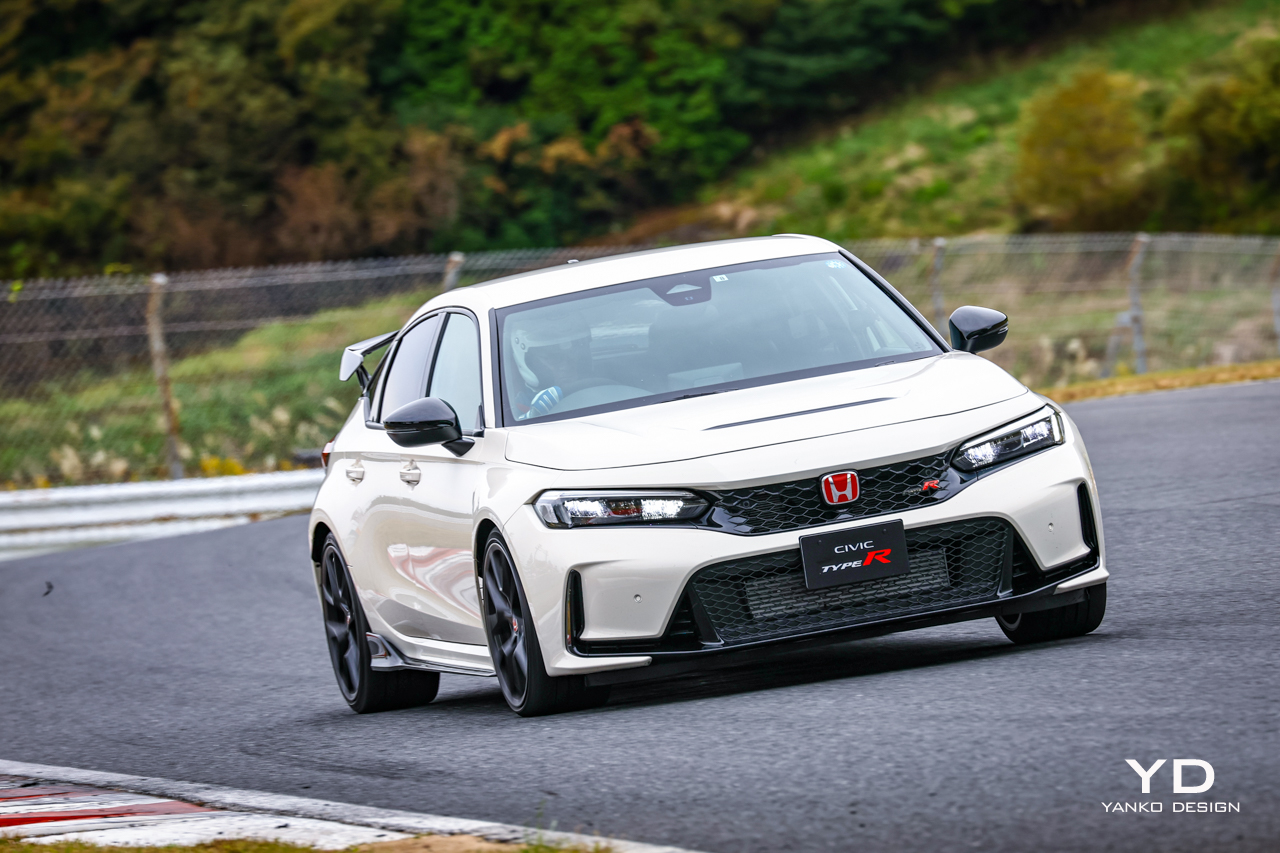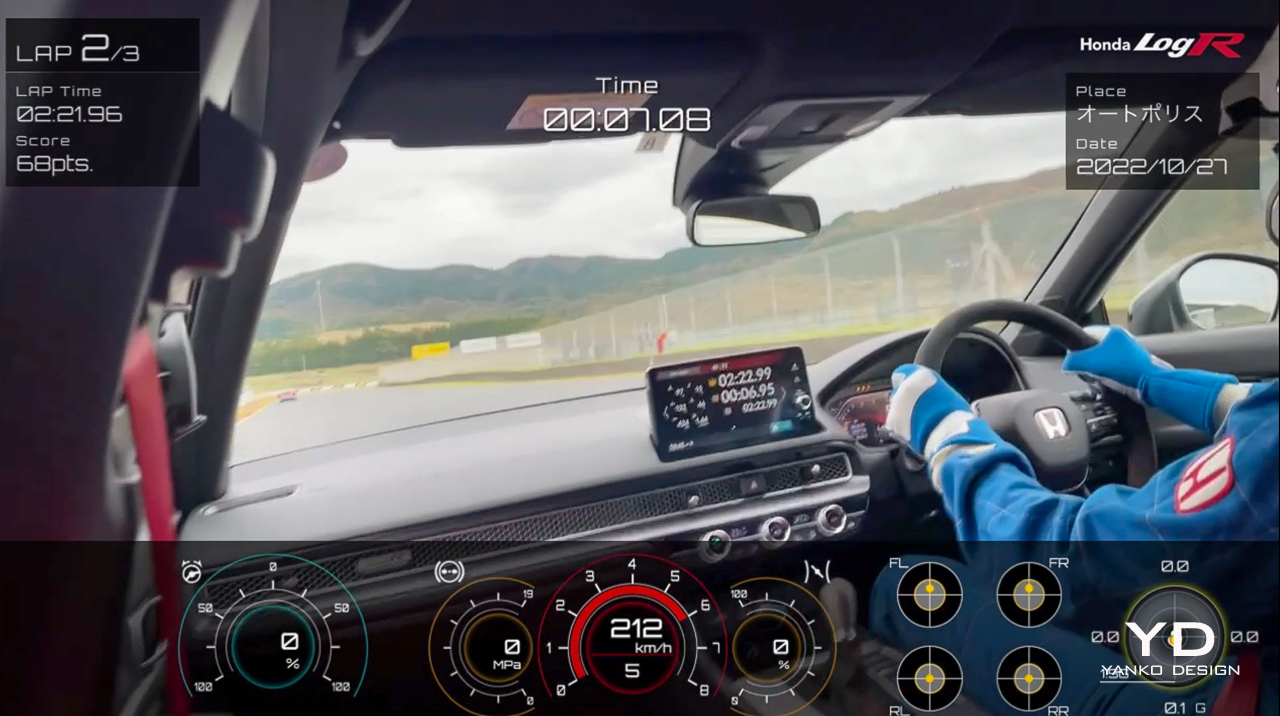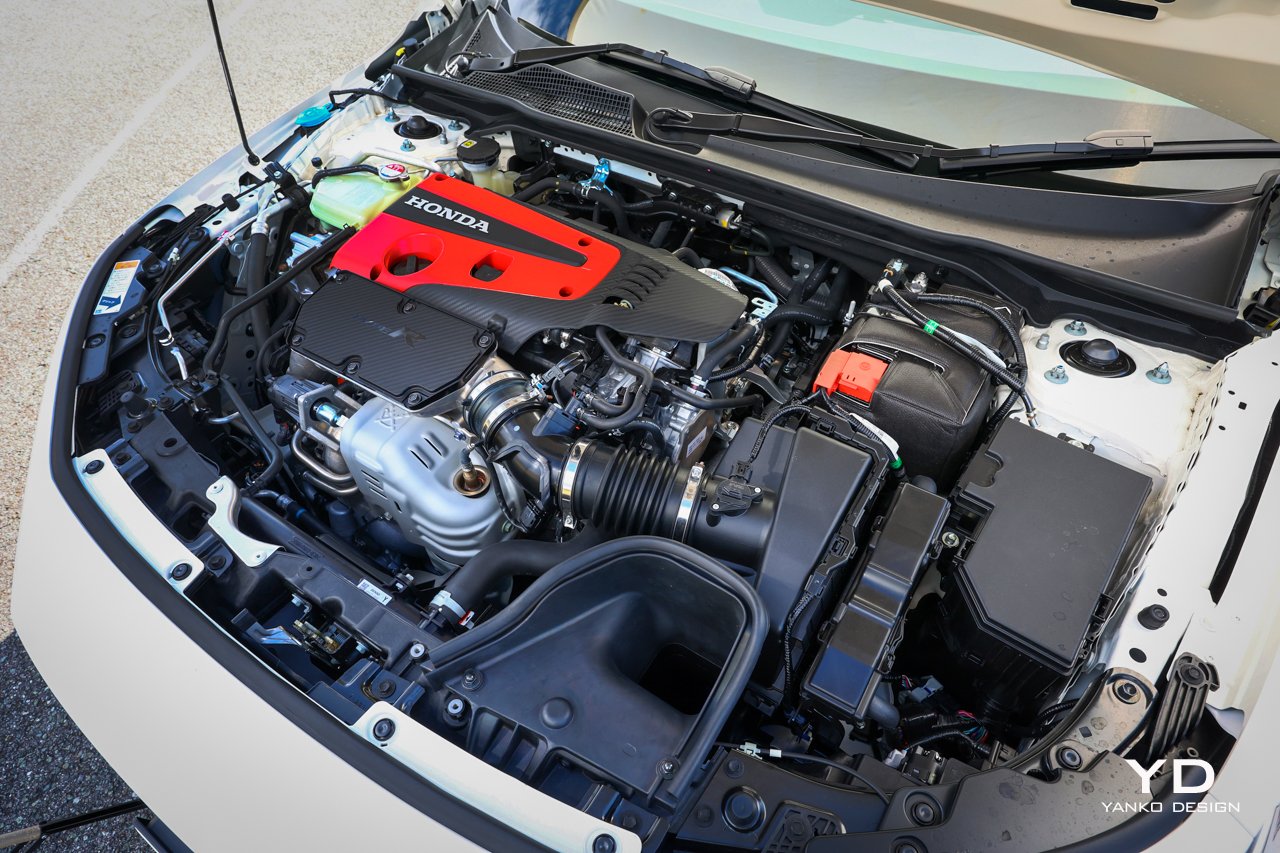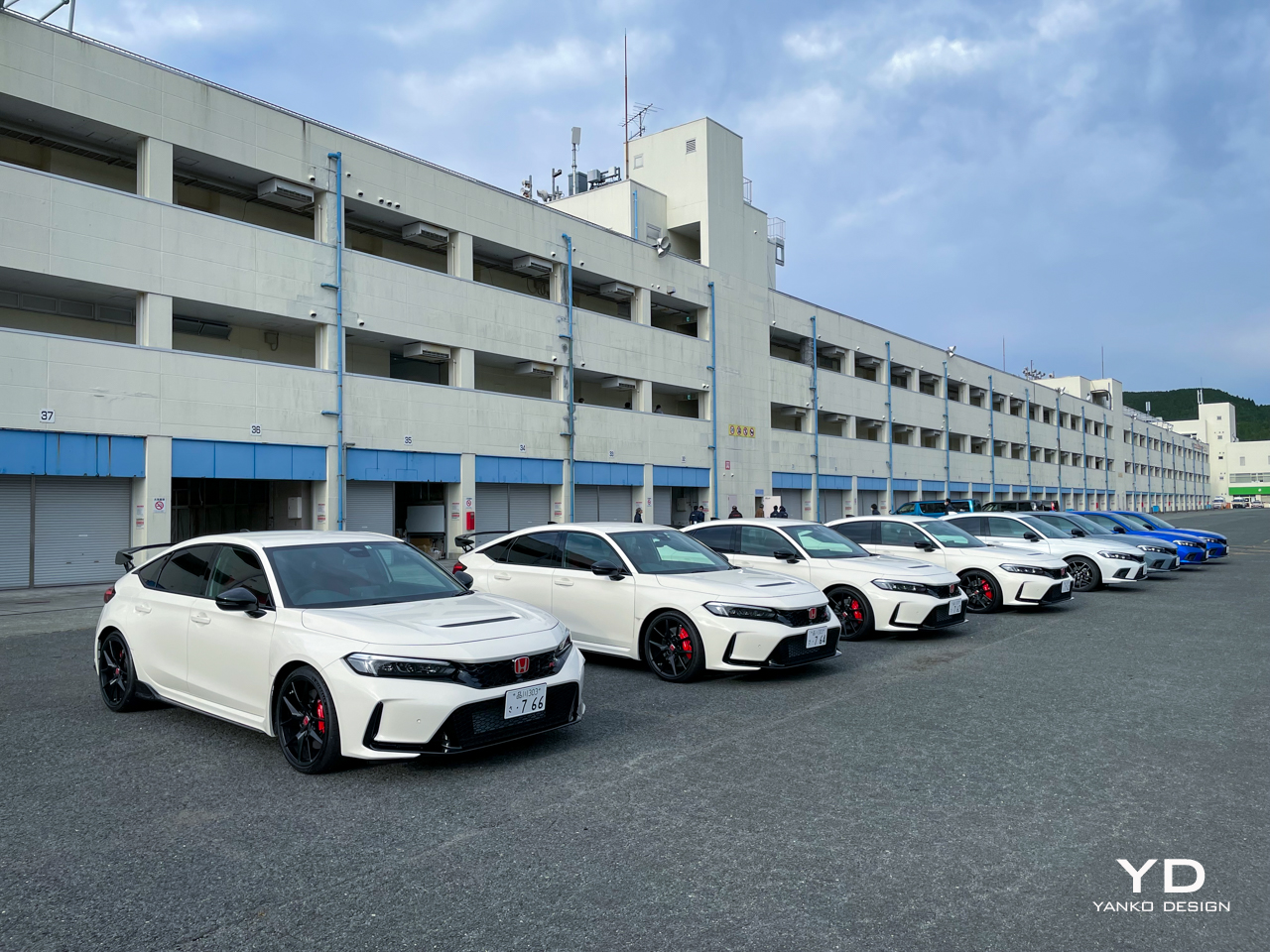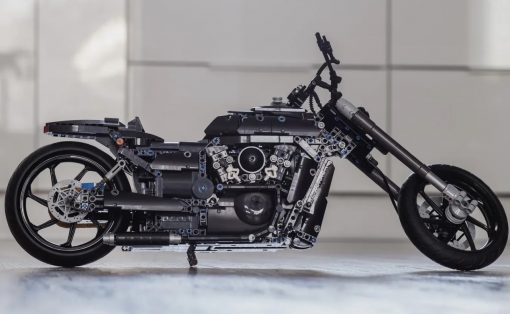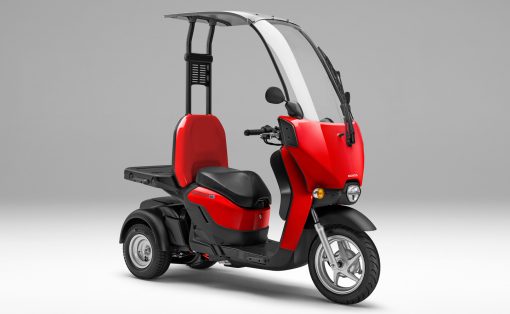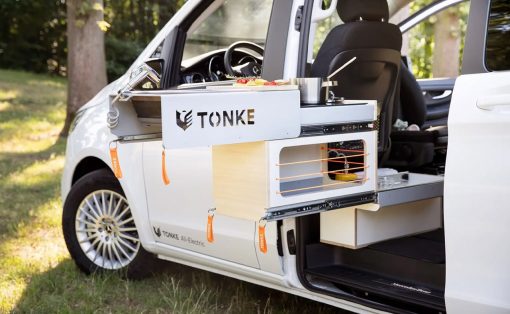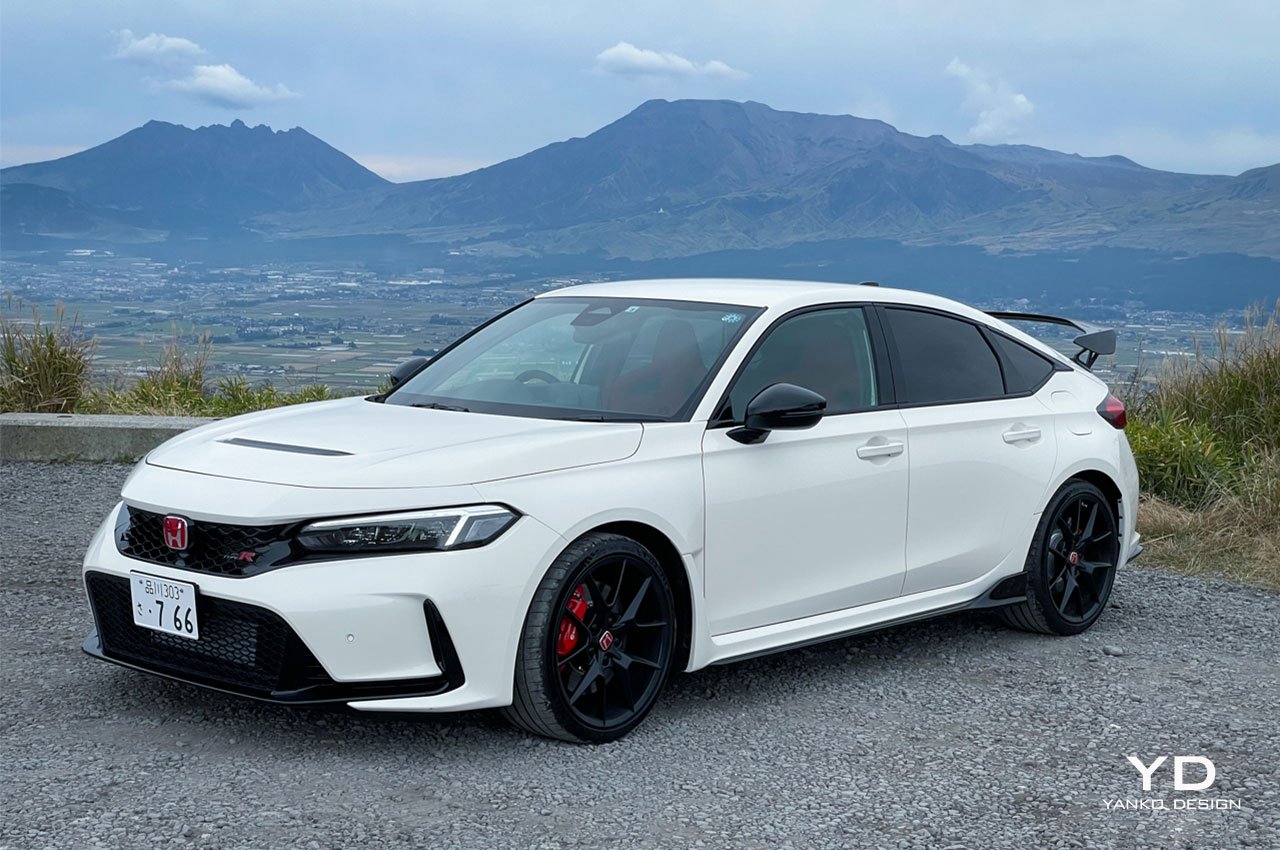
PROS:
- New more mature-looking design
- Brilliant handling
- Quicker and more responsive acceleration
CONS:
- Exhaust note could be sportier
- Cabin is very red
- The LogR data-logger only works at certain tracks
It might only be the second Civic Type R model to come to the U.S. but it’s by far the best looking and most epic handling R we’ve ever seen. And Honda tells us that they will take their new road-going scud missile to Germany’s famed Nurburgring circuit ‘soon’ to recapture the “world’s fastest front-drive car” record—the one they lost to Renault’s Megane R.S. Trophy-R back in 2019.
Hurtling at 100 mph into Corner 3 on the Autopolis Circuit in southern Japan, the new Type R was tempting me to push harder. This 2023 Type R has higher cornering speeds than its predecessor and it’s so much easier to drive at the limits of adhesion.
Its weight balance is so well-sorted that you don’t have to provoke it into oversteer to get around a corner quickly. Steering response is pinpoint accurate and superbly weighted and the 4 piston Brembo brakes wipe off speed prodigiously and with little fade.
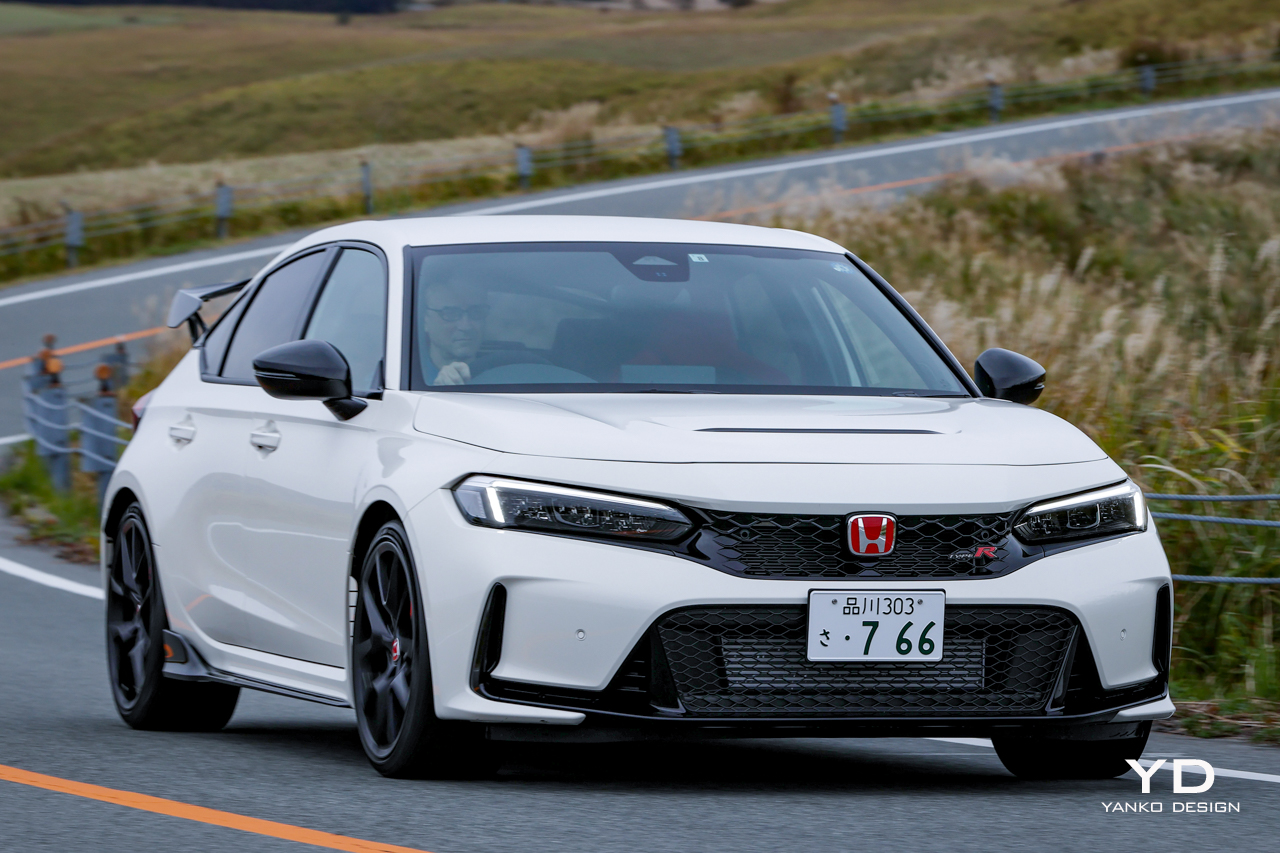
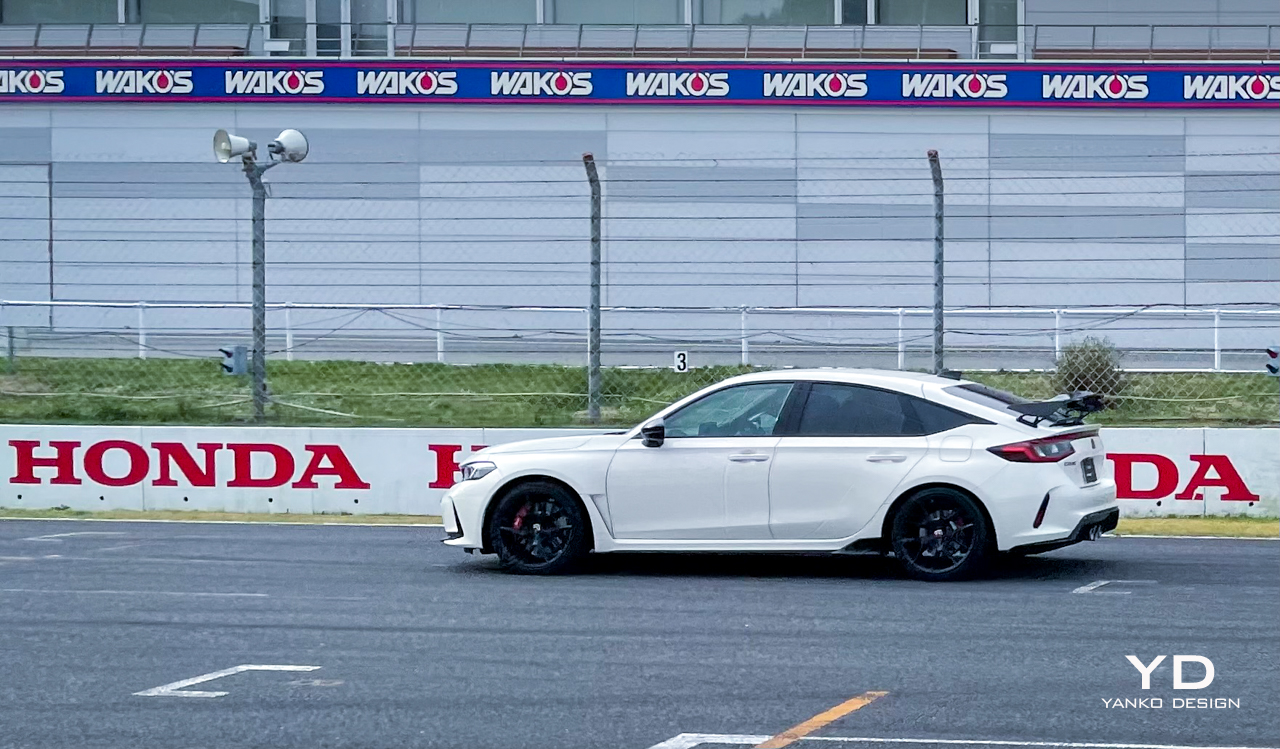
The 6th-generation is by far the best-looking
But before we dive into the juicy bits, let’s first revisit some of the brand’s history. This is the sixth generation of the Civic Type R, a high performance marque that normally appears at least a year after the base Civic launches. And this time it’s no different. Honda introduced its eleventh generation Civic in 2021, and followed that up with the hybrid version and Type R in 2022 to celebrate the 50th anniversary of the first Civic. This year also just happens to be the 30th anniversary of the very first “Type R” road car—the NSX Type R which went on sale in 1992.
The first ‘EK9’ Civic Type R of 1997 was a tame-looking 3-door hatchback based on the 6th generation Civic. It was very basic with some nice wheels, a rear spoiler and a naturally aspirated 1.6-liter pumping out 182-hp and 118 lb-ft of torque. It was the same story for the ‘EP3’ 2nd generation Type R that came along in 2001. It had new sports wheels, chunkier side skirts, a rear spoiler and a 212-hp 2.0-liter VTEC engine, but it still looked like a bread delivery van. The next ‘FN2’ Type R followed the same formula, even though it looked a little more futuristic.
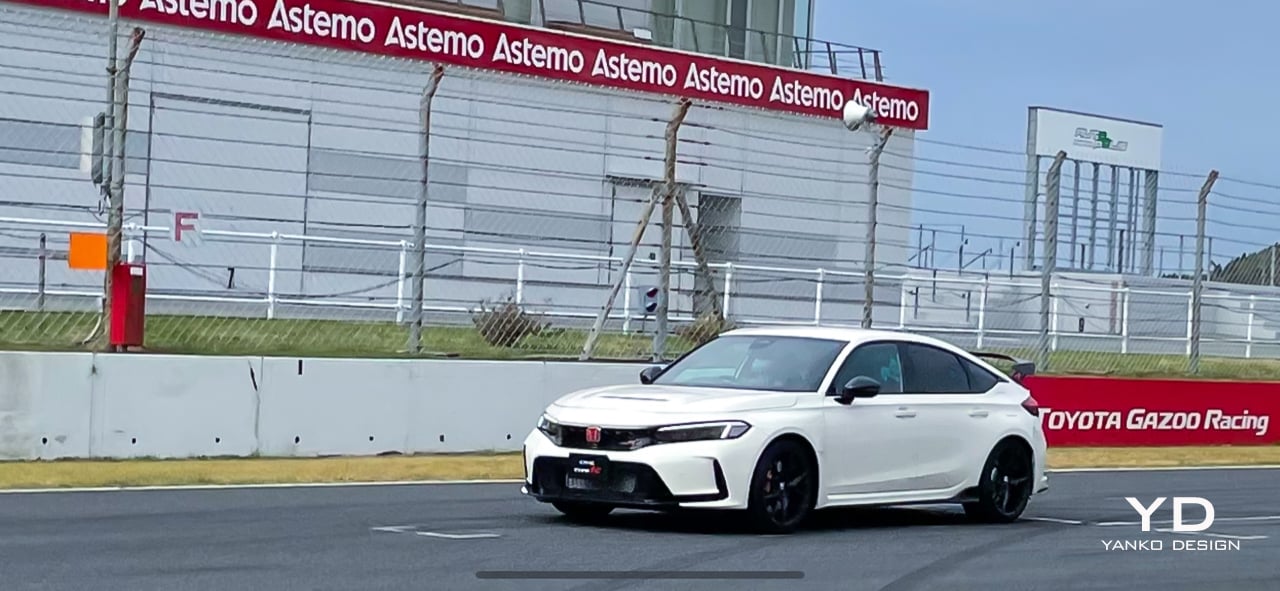
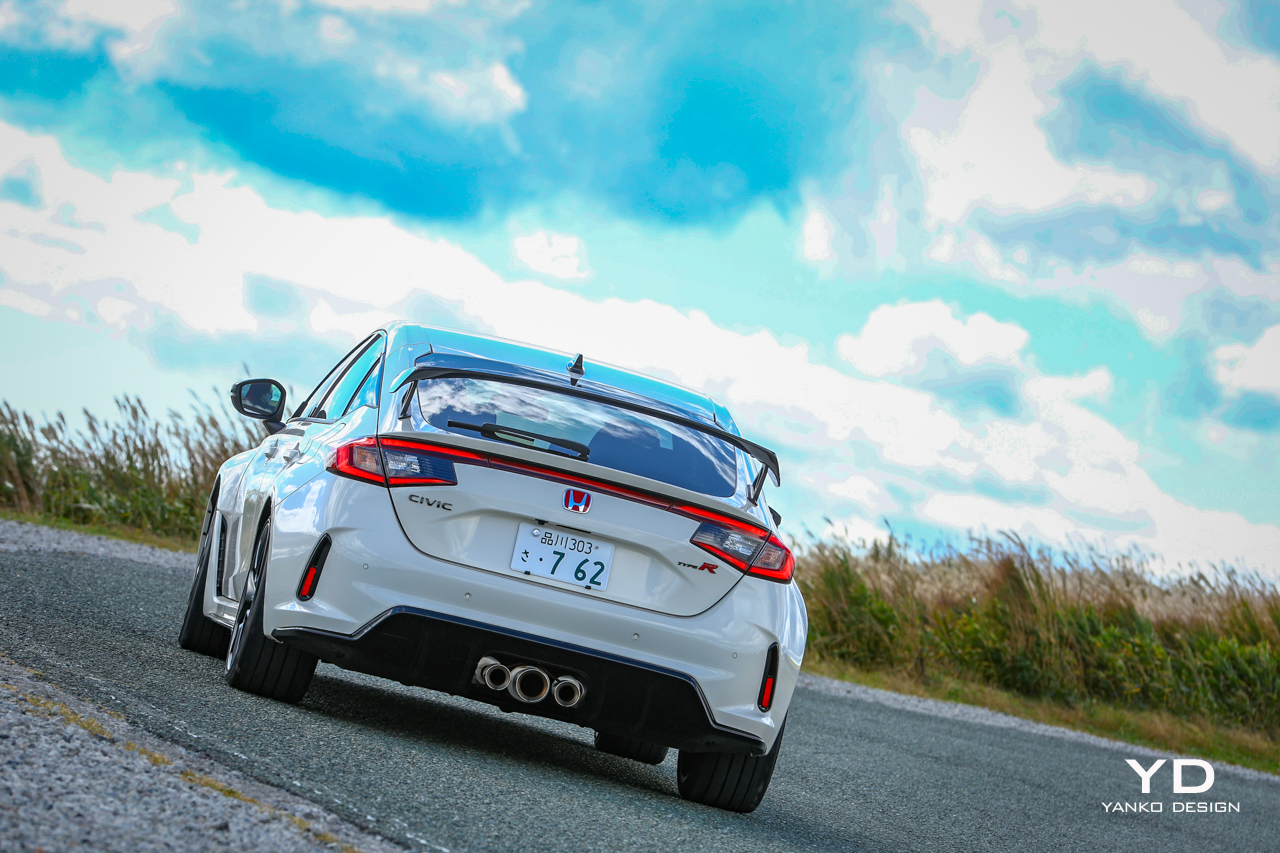
Fortunately things started to heat up when Honda revealed the more extreme ‘FK2’ model appeared in 2015. That car looked more race car-inspired boasting splitters, wings, vents and a high performance 2.0-liter turbocharged engine packing 306-hp and 295 lb-ft of torque.
Seemingly inspired by the outgoing version, Honda’s stylists threw caution to the wind with the totally over-the-top 5th-generation ‘FK8’ Type R that arrived in 2017. That car had more edges and sharp lines than a Zaha Hadid designed museum, with bigger splitters, wings, vents and hood scoops than any 2.0-liter before it.
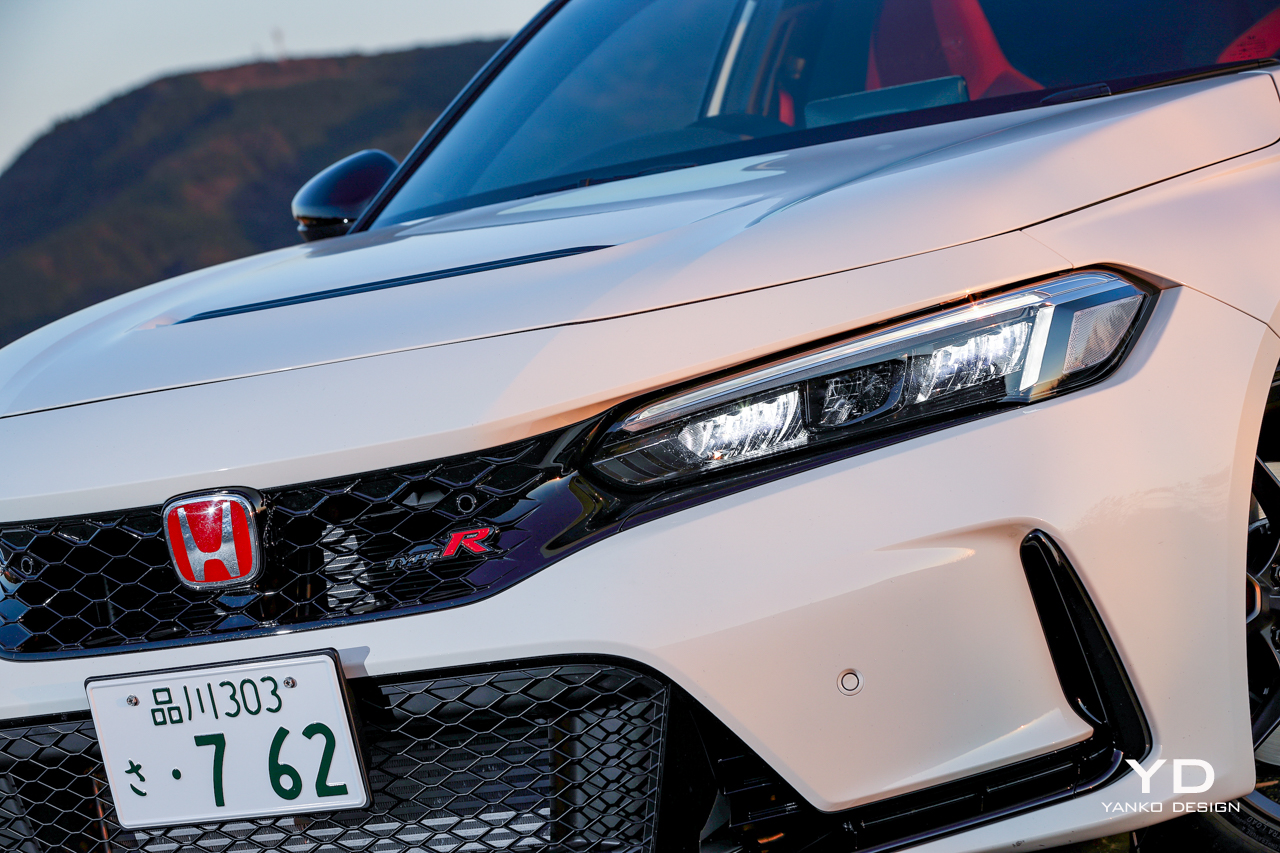
Can Honda regain its Nurburgring lap record?
But it was the 5th generation model that put the Type R name on the map when it posted a lap time of 7 minutes 43 seconds around the Nurburgring circuit in 2017, making it the fastest ‘front-wheel-drive car on the planet.’ That record, however was snatched away in 2019 when the Megane RS Trophy-R bettered Honda’s time with a blistering 7 minutes 40 seconds.
To rub salt in the wound, Renault brought their Megane to Honda’s home race track of Suzuka Circuit in central Japan in late 2019, and proceeded to rewrite the Civic Type R’s lap record by three seconds with time of 2 minutes 25 seconds. So it’s a given that straight after Honda recaptures the Nurburgring lap record, it will return to Suzuka to retake its spiritual home record. That should be something to see.
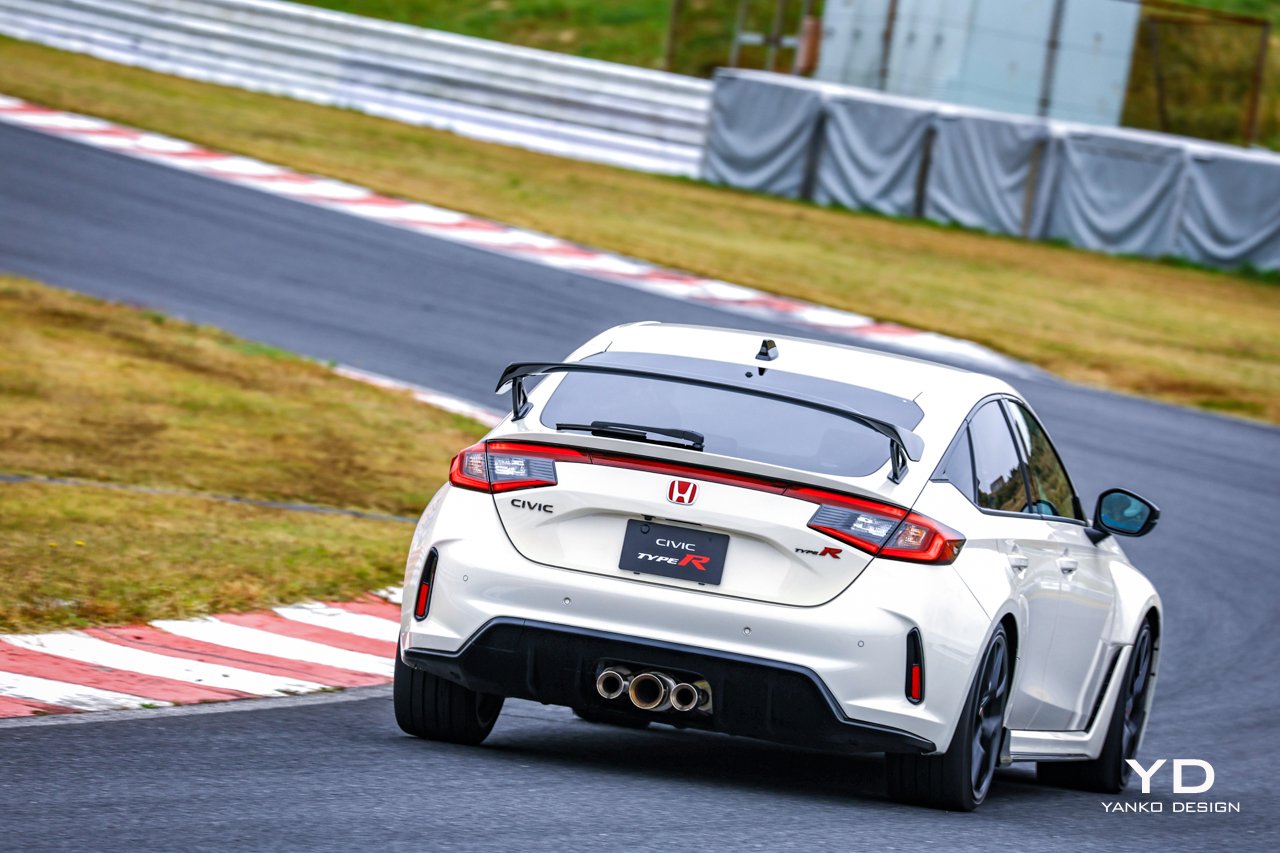
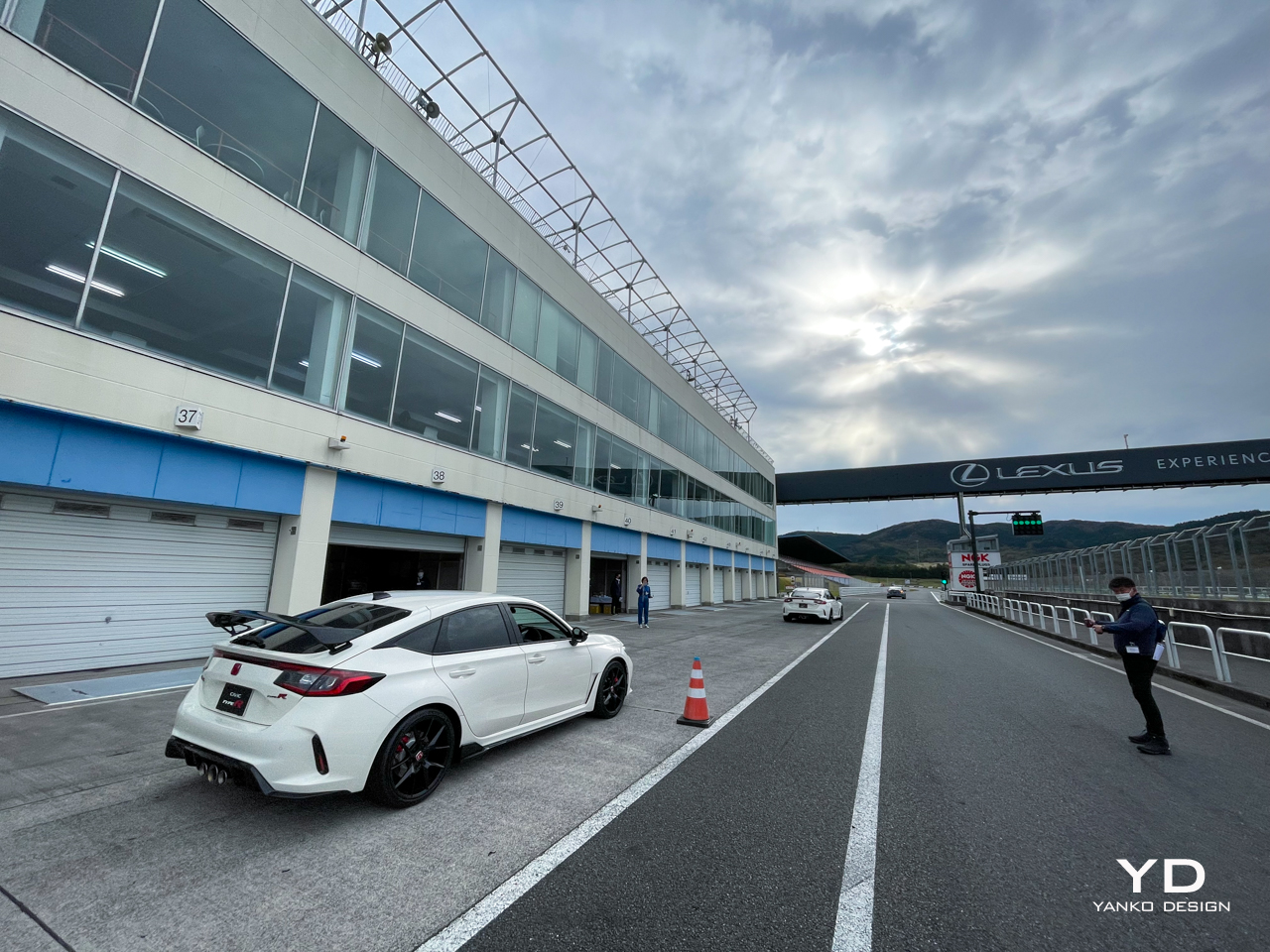
So what about the all-new car? When we say “it’s the best-looking so far,” we don’t really have much to compare with, given that the predecessor employed such busy styling that it looked strangely like something from Transformers. Of course, if you back to the earlier models, the ones that did not make it to the U.S., then we can see the evolution of the series. Even if we compare the new model to the previous five generations, with original version first surfacing in 1997, then we would still say that the latest version is the best-looking.
One look at the all-new model and you can see that it is altogether more mature and less flashy. Gone is that edgy, boy-racer styled, Fast and Furious-inspired design, replaced by more subtle edges and a less angry face. One colleague even suggested that it looked a lot like an Accord, and I had to nod in agreement. One reason—there’s no more 3D protruding hood scoop, a definite sign that Honda is trying to dial down its boy-racer image.
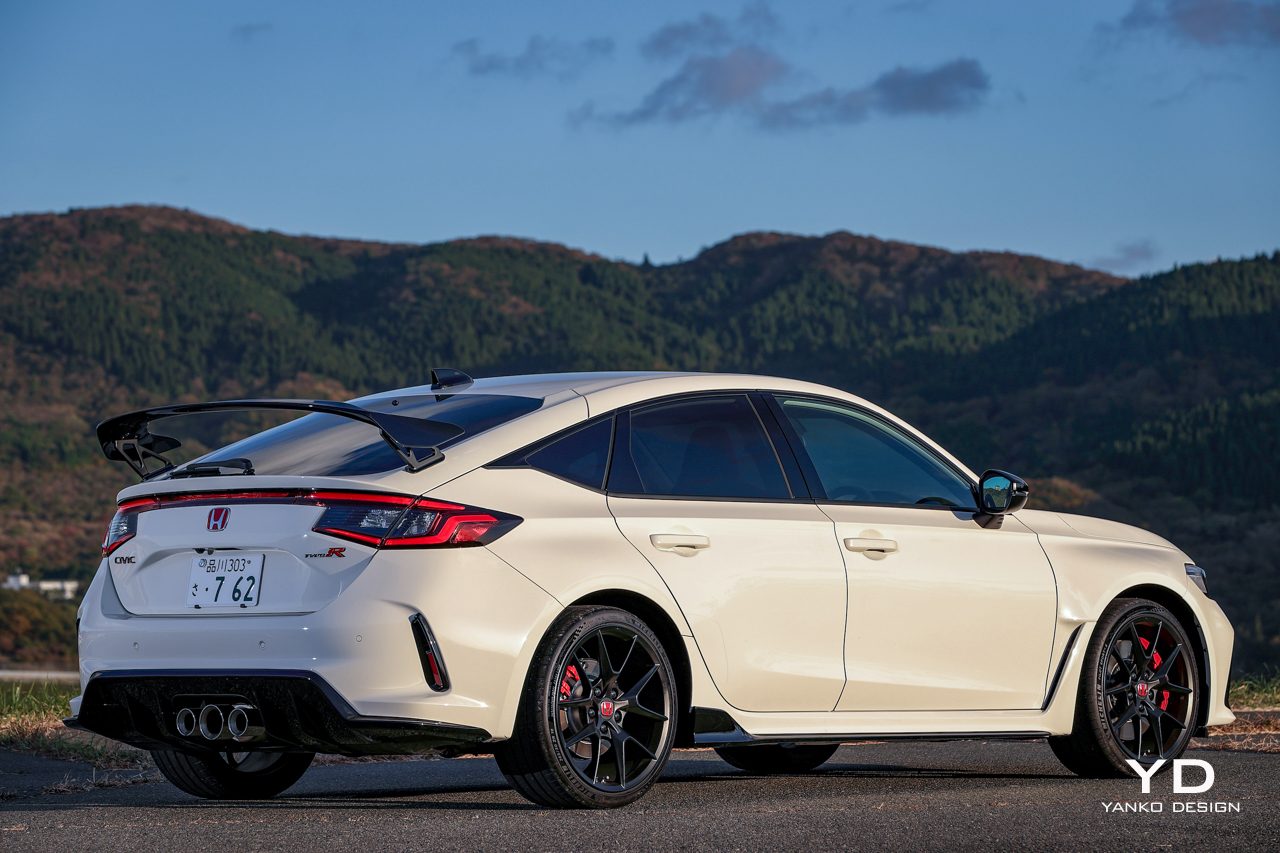
New Type R is more mature but still has plenty of attitude
Mind you, the Type R still has attitude, a lot of attitude. From its improved aero-body and triple exhaust pipes, to its brake-cooling front air intakes to its huge rear wing and rear diffuser, the Type R screams high performance. That’s right, all of the vents are real and functional this time, which adds to the car’s performance and helps to slice precious seconds off of lap times. The rear spoiler is still bigger than anything you would find on an Audi S3 or Mercedes-AMG A35, but this time, the R’s wing sits on shorter, more aerodynamic vertical struts rather than huge vertical metal plates like on its predecessor.
To keep the high performance nuance at max however, Honda retained the cool Ferrari-inspired triple aluminum exhaust design feature and carried over the rear diffuser from the old model. Also, the fake rear vents on the outgoing version have been replaced by a much smoother and more mature-looking rear bumper. The new model also gets a set of black side skirts, like the predecessor, but the stuck-on wheel arch extensions have thankfully gone. Instead, you now get flared wheel arches that have been neatly smoothed to sit flush with the bodywork. In addition, the cool-looking vent behind the front wheel is functional in that it cleans up the airflow coming out of the wheel arch to reduce drag down the side of the car.

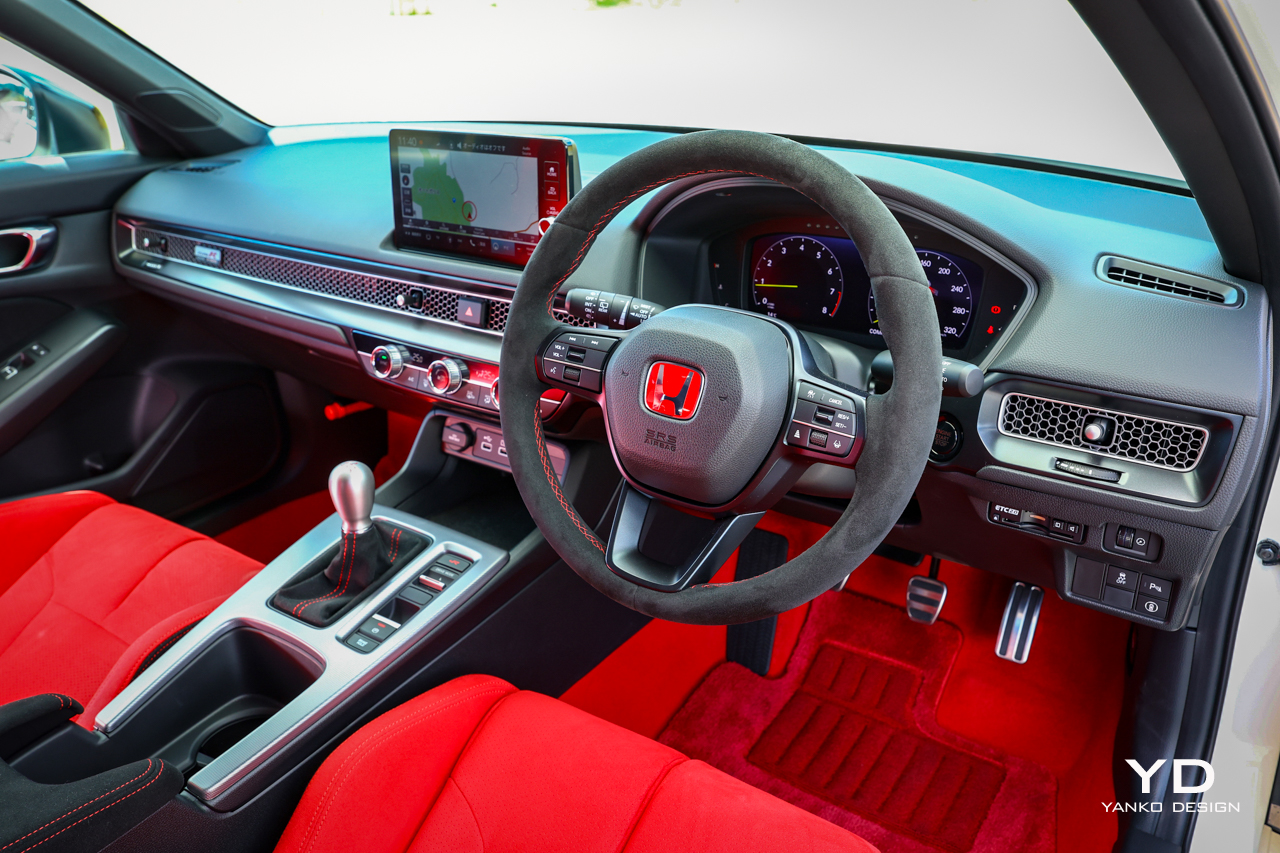
All of these upgrades combine to make the new car not only more aerodynamic and planted, but make it look far more mature. It still stands out of course, but you won’t be embarrassed to show it off to your car buddies.
Inside, the Type R hints strongly at what it was made for. With its bright red seats and carpets, red stitching on a black Alcantara-wrapped steering wheel (to help soak up sweat!!) and its aluminum accented dash, the R lifts the adrenalin level even before you fire up its engine. But perhaps, stylists may have used a little too much red. It’s everywhere. The compact aluminum gear knob, that fits perfectly in the palm of your hand, is vintage Honda and puts a smile on your face every time you flick through the gears. I’d argue that it’s mechanical precision and nice short throws are nearly as good as the 6-speed stick shift on the NSX, or at least as good as that on the now-out-of-production S2000.
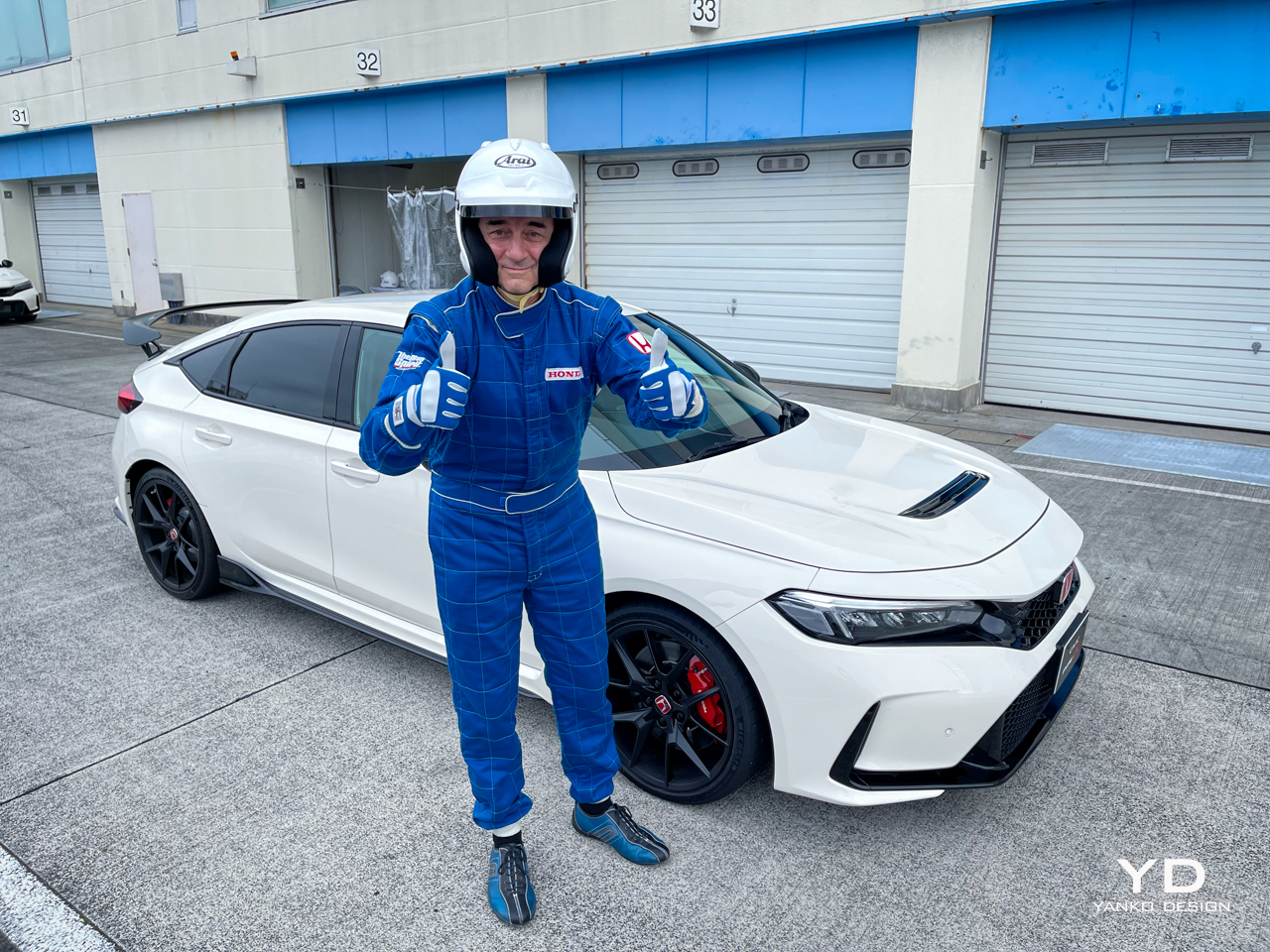
In the hot seat
Speaking of that engine, there is some good news about that too. The new Civic doesn’t just benefit from weight saving and beefier rigidity, it also employs the most powerful Type R powerplant ever courtesy of its uprated 2.0-liter turbocharged four-cylinder engine. This unit gets revised turbo geometry, improved cooling and more exhaust back pressure to sharpen up its responsiveness. It’s married to that brilliant 6-speed manual gearbox and pumps out 315-hp and 310 lb-ft of torque, increases of 9 hp and 15 lb-ft over the old Type R.
Exercise your right boot generously and the tacho and digital rev bar climb quickly towards its 7000rpm redline, complete with blinking F1-style red gearshift lights. Power arrives in a constant, linear ascent, and almost feels naturally aspirated in the way it climbs. Keep the turbo spinning between 3000 and 7000 and you’ll have prodigious amounts of power ready for the taking. But because of revisions to the chassis and suspension, you’re able to get that power down onto the tarmac better than ever before, a development that realizes quicker lap times.
The Type R continues to use Honda’s automatic rev-matching tech, which is now 10% faster according to Honda. Of course, you can switch it off if you prefer to heel-and-toe for real, but it works superbly when left on. Also, the rev-matching helps to make day-to-day driving smoother and is a helpful feature for those new to manuals.
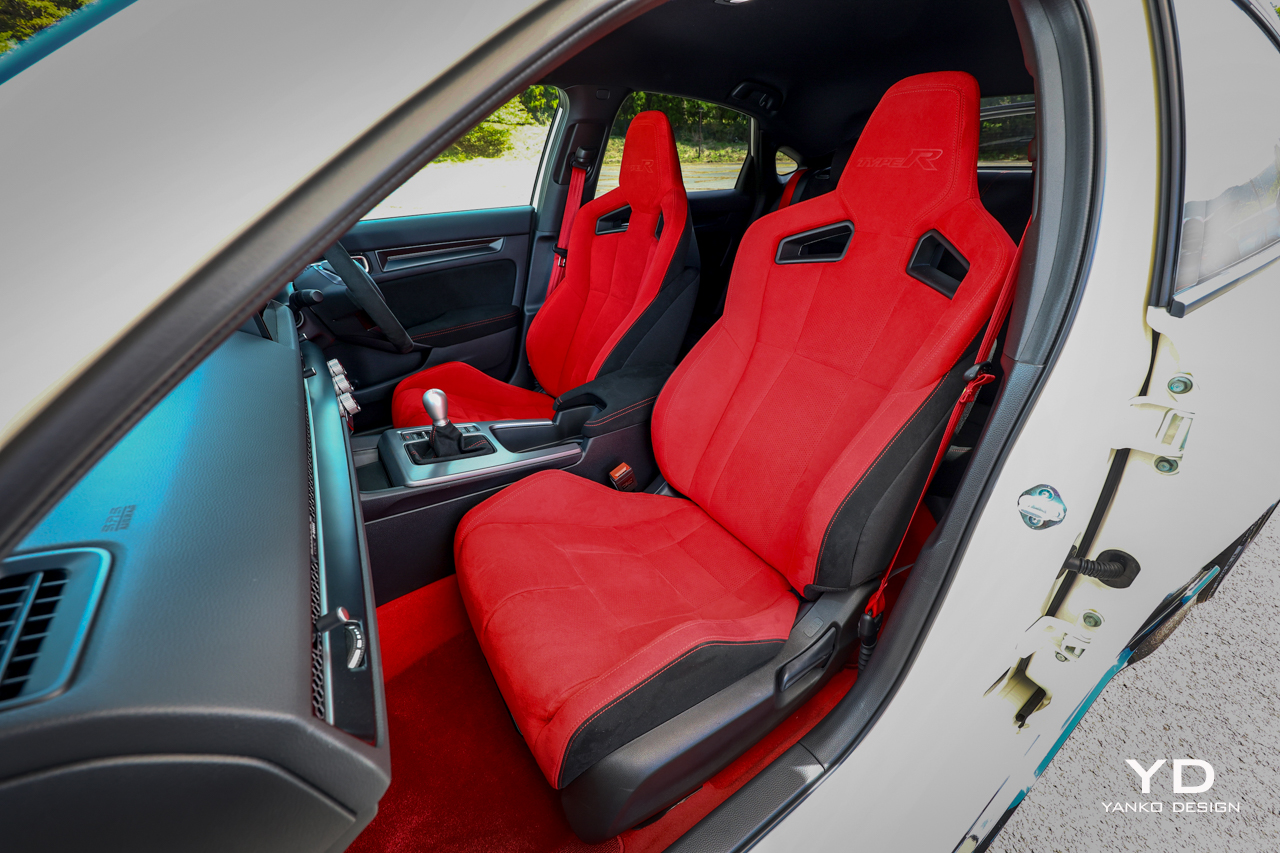
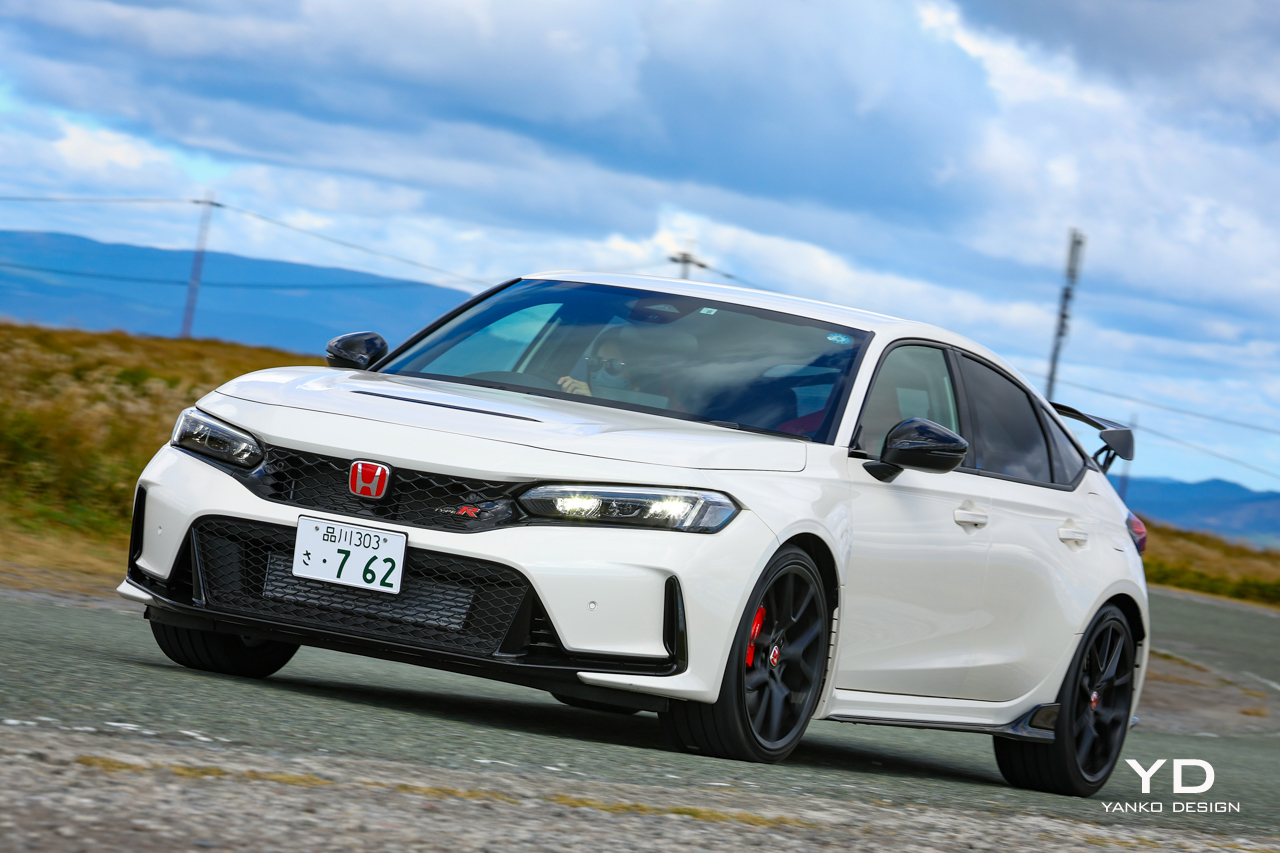
The Autopolis track was the ideal place to put this R through its paces. As I punched the brake pedal quickly and grabbed 3rd on entry to a 70mph right-hander, the R hunkered down with massive grip from the Michelin Pilot Sport 4S tires and then launched out of the exit with an almost overconfident “is that all you got?”
This car feels seriously quick, light, chuckable and genre-beating. It just gets on with the business of driving as fast as the pilot wants, but making that driver feel like a production car series hero in the process.
It is very clearly in its element on a race track. But it does feel stiff. We took it for a one-hour on public roads too and while the car can cope with bumps and tram-lines and potholes, the Type R is definitely on the firm side.
When you drive at full throttle on a circuit like this, it occurs to you that the “Fastest front-wheel-drive car in the world” (as Honda says it will be!) was made possible thanks to the development team’s efforts in fine-tuning their Type R entry in Japan’s Super Endurance Series. The difference in acceleration and handling between the previous generation and the new model was eye-opening and grin-generating.
The front suspension has been modified to provide improved traction and turn-in at the limits, while the rears squat nicely thanks to their reinforced rear rigidity, providing better around grip and quicker exits from corners.
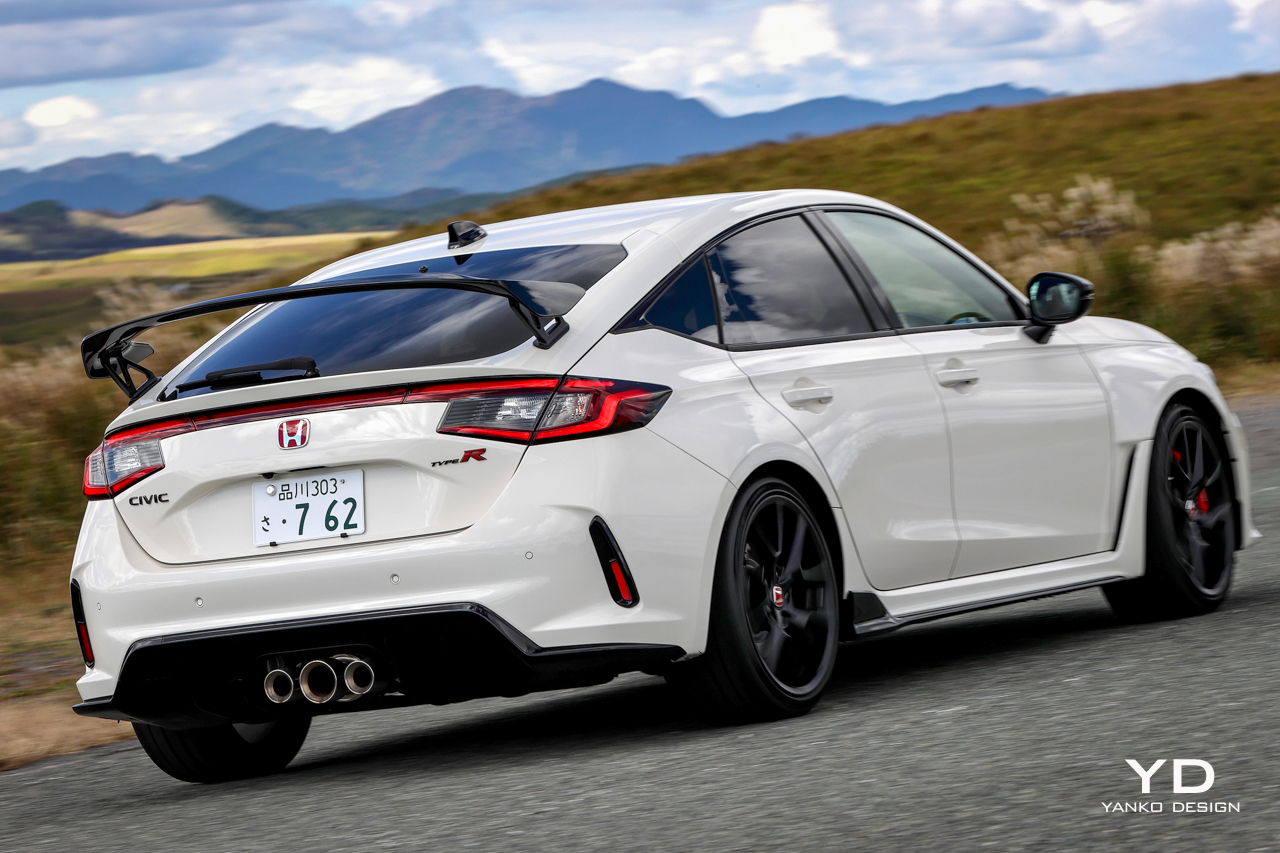
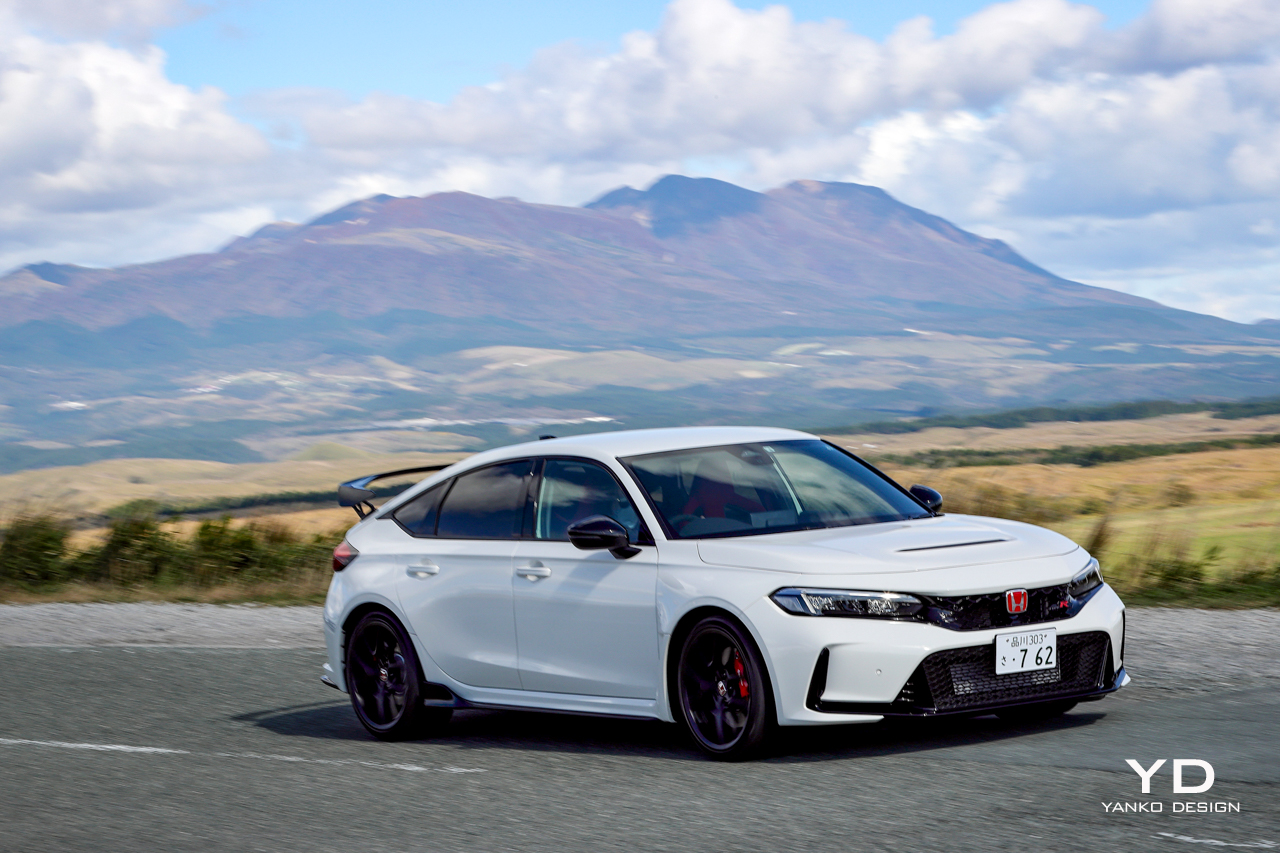
To elevate the thrill level on track, Honda has fitted a data logger, aptly named “LogR.” This device will time your laps, but more importantly, determine how good your driving technique is and then give you a score. During my test drive session, former Japan Touring Car and F3000 champion racer Akihiko Nakaya scored 96 points, the best score of the day. My score was a little lower as I was not as familiar with the track as he was, or at least that’s my excuse.
The only downside is that the Type R still doesn’t sound as sporty as it should, even with the new model’s improved exhaust flow and active valve design. If only the designers, or should we say engineers, had added as much aggression in the sound department as they have in the aerodynamics and interior styling departments. It doesn’t bark, pop or crackle like a Toyota GR Corolla, Ford Focus RS or Hyundai Elantra N, and the synthetic exhaust note pumped inside through the speakers needs a tweak.
Expectations are high for the new model, as the previous generation became a hit, selling 47,200 units worldwide. I am half saddened by the thought that this will be the last gasoline version of the Type R that I will be able to test drive on the race track. I am half enthused though to see what the Type R electric version might look like.
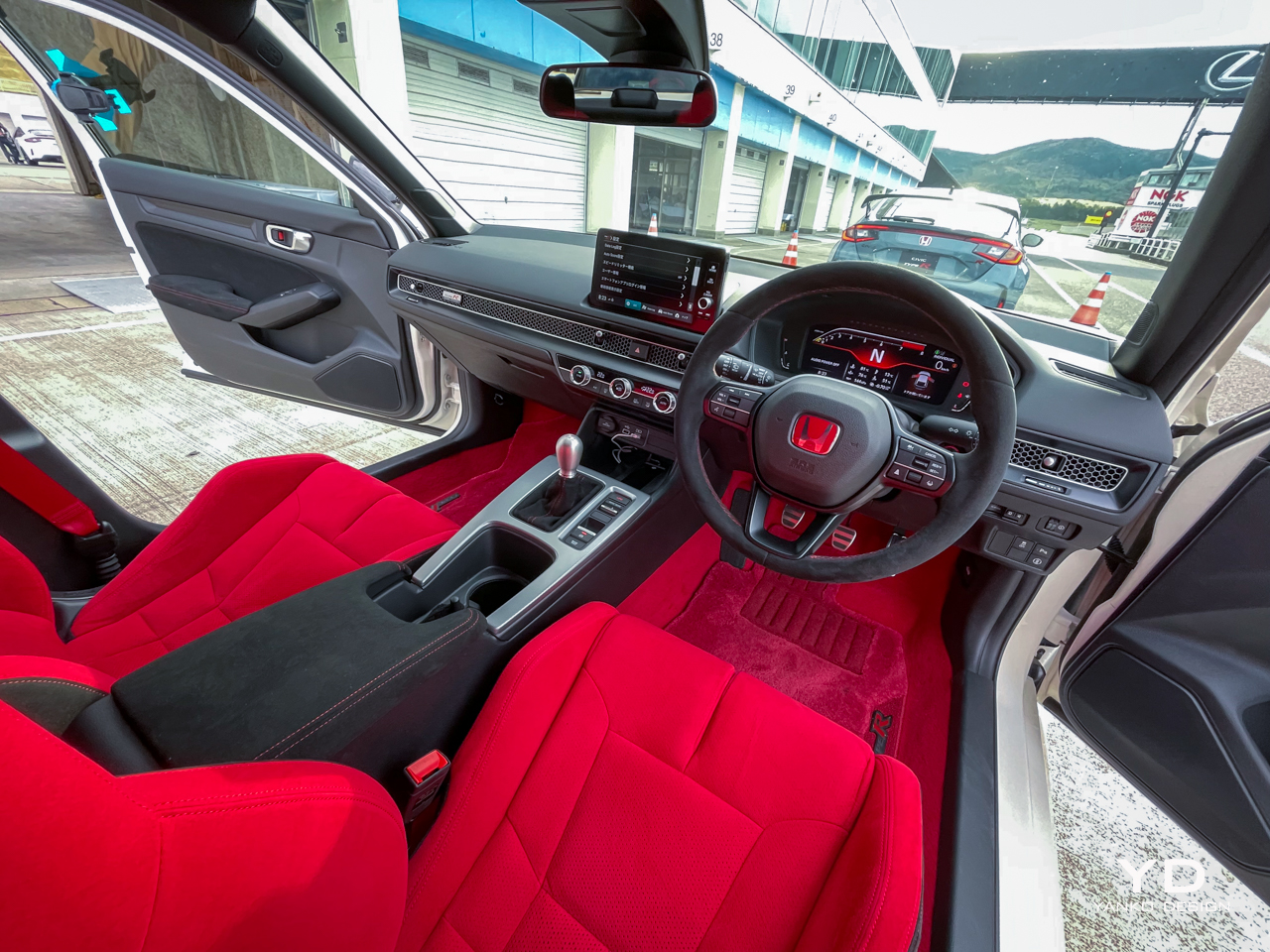
Pricing and Options
Rivals from Toyota, Hyundai and Renault, for example will be the Type R’s strongest competitors, especially since they significantly undercut the Honda’s $43,990 base price. As far as options go, the Type R pretty much comes like this straight out of the box. You can choose from one of two Michelin brand tires, including the more road-going friendly Michelin Pilot Sport 4S we used in Japan.
Put up against its rivals, the Type R may be a little more expensive, but then again, if Honda can recapture the R’s ‘fastest front-drive car’ title at the Nurburgring, then the extra status could be a deal-maker.
